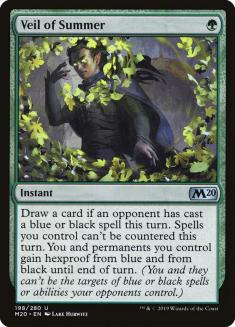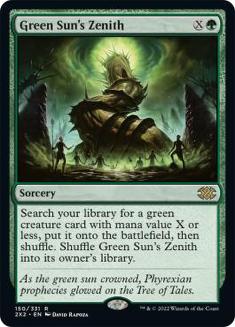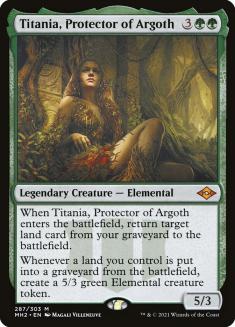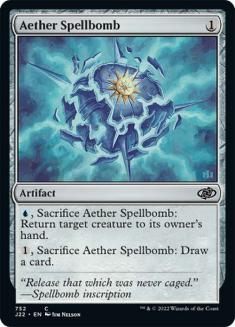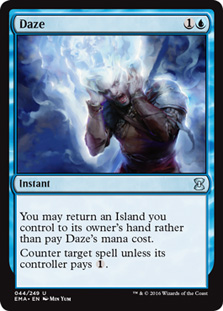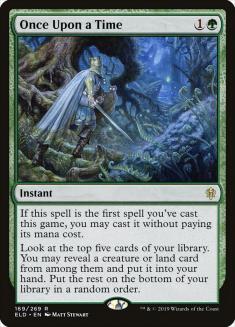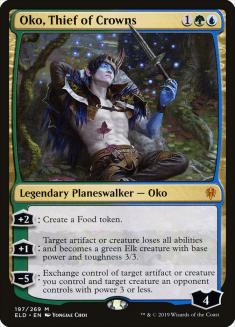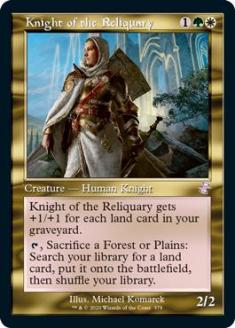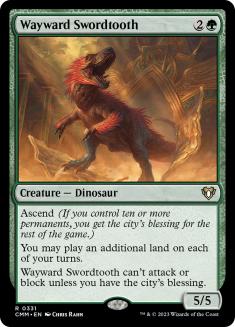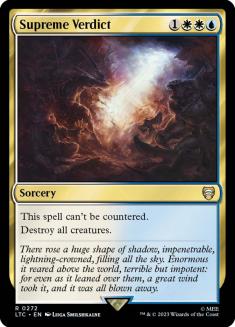This past weekend, I competed in the championship tournament for the Nerd Rage Gaming (NRG) Series, the culmination of a year-long tournament series in the Midwest run by Chicago area-based Nerd Rage Gaming. I qualified via an at-large slot through points accumulated throughout the season. 24 players were qualified for the event, and all of them participated.
Like many small championship tournaments, this used a unique tournament structure to showcase several formats. The first day consisted of three groups of pod play with one pod each playing Pioneer, Modern, and Legacy. I’m personally not a fan of pod play in general, and I didn’t like the structure of this tournament in particular, but I need to explain it to explain how the tournament went.
Each pod contained four players, so there were six pods. First players were paired at random in each pod and played a match, then the winners played each other and the losers played each other. Finally, there was a third round in each pod, but only the two players who were 1-1 played each other. There was a 50% chance this would be a rematch. After that match was complete, the player who finished 2-0 was awarded three points, the 2-1 got two points, the 1-2 got one point, and the 0-2 got zero points.
As this tournament played out, all players with six points at the end of the three pods made the Top 8, but I’m led to believe that it wouldn’t necessarily have been a clean cut.
This means every player played anywhere from six to nine matches on Day 1, and, as it happened, I only played six matches.
This was a 24-person $10,000 tournament, so the stakes were reasonably high, but I’m still me, which means I’m pretty confident and care a lot about playing fun and interesting Magic, so I played original decks that I built in Legacy and Pioneer, and Urza Control, a deck I had a heavy hand in the collaborative development of, in Modern.
The tournament started off with Pioneer.
For a lot of my preparation, I’d been working on various Doom Foretold decks, but couldn’t get them quite where I liked them, even though it felt like there was something very powerful there. Our decklists were due Thursday evening, and Thursday morning I recorded Pro Points with Andrew Cuneo as a guest on our podcast. We discussed my deck selection process for the tournament, and Andrew happened to mention that he thought a Collected Company deck with Wayward Swordtooth might be good, so I decided to throw such a deck together after we finished. I played three Leagues with the deck throughout the day, improving the deck after each of them, and managed to get a 5-0 finish in the last League after adding Sylvan Advocate to my deck, so I decided to play it in the event. This is the list I played:
Creatures (28)
- 4 Courser of Kruphix
- 1 Nissa, Vastwood Seer
- 4 Sylvan Advocate
- 4 Tireless Tracker
- 3 Ramunap Excavator
- 4 Wayward Swordtooth
- 2 Thorn Lieutenant
- 2 Fae of Wishes
- 4 Brazen Borrower
Planeswalkers (1)
Lands (27)
Spells (4)

The purpose of this deck is to use Wayward Sworthtooth to play multiple lands every turn, generating Clues with Tireless Tracker. Courser of Kruphix and Ramunap Excavator make sure that you have more lands to play, and the deck plays eight fetchlands to maximize the chances that Ramunap Excavator always allows you to play a land and generate the most possible landfall triggers with Tireless Tracker and Wayward Swordtooth. Any two of these creatures play well together, and Collected Company helps you get multiples of them on the battlefield.
My first match was against Louis Kaplan on Azorius Control. I lost the first game when he used Teferi, Time Raveler to cast a Supreme Verdict on my turn when I attacked with two Mutavaults, which forced me to transform Westvale Abbey and hope he couldn’t answer it (which was extremely unlikely) and I conceded to a Cast Out. In Game 2 I never drew any of my counterspells and lost to a Turn 5 Lyra Dawnbringer.
My next match was against Boros Knights with four maindeck Brave the Elements, and while I might have been able to win if I’d gotten luckier with Courser of Kruphix revealing lands, my deck is very poorly set up against four Brave the Elements.
I was disappointed with my start and with my deck, since it didn’t feel good against Azorius Control, which many players had decided to play. Moving forward, I’d cut the Nykthos, Shrine to Nyx for a fourth Mutavault and the two Thorn Lieutenants for another Nissa, Who Shakes the World and a Nissa, Vital Force to help with the control matchup.
My poor start meant I needed to win out.
Legacy was up next and I didn’t know what to expect. I’d built my deck by theorycrafting after watching Louis Kaplan play Legacy next to me in a team event in which he played Golgari Depths, and by watching the Star City Games Players’ Championship.
I decided that Veil of Summer was the defining card of Legacy and I wanted a deck that could use it and not validate my opponents’ copies. This meant I needed to play neither Force of Will nor Thoughtseize. This is a tall order in Legacy because it’s very hard to beat combo decks without counterspells or discard, but I know that it’s possible with land destruction and hatebears.
I also knew that I wanted to play Once Upon a Time, which looked great whenever I watched Louis cast it. That meant I needed to play a deck that used high impact creatures.
Given these motivations, this is what I came up with:
Creatures (14)
- 1 Sylvan Safekeeper
- 4 Noble Hierarch
- 4 Knight of the Reliquary
- 1 Scavenging Ooze
- 1 Titania, Protector of Argoth
- 1 Tireless Tracker
- 1 Palace Jailer
- 1 Questing Beast
Planeswalkers (4)
Lands (25)
Spells (17)

My thinking was that between Mox Diamond, Noble Hierarch, and Green Sun’s Zenith, I’d likely have the fastest Oko, Thief of Crowns in the Oko mirrors, which is a good place to be. Also, all those extra mana sources combined with Once Upon a Time and Life from the Loam meant that opposing mana denial strategies, which are common in Legacy, wouldn’t work well against me. Knight of the Reliquary, Swords to Plowshares, and Oko, Thief of Crowns meant I’d be extremely well positioned against opposing Dark Depths decks, and Veil of Summer and Oko would give me an edge against blue midrange decks.
That felt like a majority of decks I tend to see players gravitate toward in Legacy, buy it certainly doesn’t cover everything. There are a wide variety of proactive combo or linear decks. Most, but not all, of those decks are one or more of: artifact decks, graveyard decks, and spell-based combo decks. My sideboard attempted to cover my bases there with cards like Collector Ouphe, Rest in Peace, Gaddock Teeg, Spell Pierce, and Deafening Silence.
In my first match I played against Bomberman, and my opponent used City of Traitors, Lotus Petal, Mox Opal, two Lion’s Eye Diamonds, and Karn, the Great Creator (the perfect six cards) to lock me out of the game on Turn 1 with Mycosynth Lattice. Sometimes these things happen in Legacy.
I managed to win Game 2 by protecting a Gaddock Teeg and Game 3 off the back of Deafening Silence.
My next match was against Bant Snow, and it played out basically the way I imagined: my faster Okos and Veil of Summers were very good, and Green Sun’s Zenith meant that I was very good at pulling ahead in the mid-game, especially since my deck didn’t have a bunch of air in the form of Arcum’s Astrolabes, Ponders, and Brainstorms. My opponent did critically misplay early in Game 2 after getting ahead by playing Oko first with three Arcum’s Astrolabes by not playing aggressively enough, which gave me the wiggle room I needed to stabilize. It was a very fun match.
I was extremely happy with my Green Sun’s Zenith bullets. Specifically Tireless Tracker and Titania, Protector of Argoth were fantastic, but Questing Beast and Sylvan Safekeeper pulled their weight. (I didn’t happen to play against decks where Scavenging Ooze was especially important.)
Lastly, I needed to win my Modern pod. Fortunately, I was playing Urza Control, which I think is simply the best build of the best deck and I keep hearing glowing reviews from people who try it out. Wyatt Darby was on the coverage team for the event and told me he’d tried it and won his first thirteen matches on Magic Online.
I played this list:
Creatures (12)
Planeswalkers (4)
Lands (20)
Spells (24)

There are a few card choices I’m not 100% locked into in this deck. I like the third Mystic Sanctuary, but I think most other players only play two, which is defensible. Metallic Rebuke and Aether Spellbomb are somewhat flexible slots, but both should be cheap spells, and ideally interactive spells. I think Aether Spellbomb is under appreciated.
The lands are also a little up for debate, specifically in that the second Breeding Pool can be a different blue shock if you want to sideboard cards of a third color and the basic Forest isn’t strictly necessary.
I consider the second Breeding Pool rather than another shockland to be a small upgrade, but I decided that I didn’t really want any of the cards another color offered me in the sideboard. I think the best options are Path to Exile and maybe Teferi, Time Raveler out of white and Fatal Push, Thoughtseize, Drown in the Loch, and maybe Dead of Winter out of black, but I just don’t like the way the deck plays out after sideboarding when it needs to worry about finding three colors of mana and I think the sideboard cards available in two colors cover everything you need.
I think Ice-Fang Coatl and Archmage’s Charm are huge upgrades over Emry, Lurker of the Loch and Karn, the Great Creator or whatever else someone might play. They give you a lot more velocity to find your other good cards and faster, more reliable returns than Emry. Most importantly, I think this switch flipped the Death’s Shadow matchup from slightly unfavorable to heavily favorable without really hurting anywhere, and offered smaller improvements in many other matchups.
In my first round I played against a Four-Color Zoo brew with Wild Nacatl; Stoneforge Mystic; Mantis Rider; Oko, Thief of Crowns; and The Royal Scions. The Stoneforge package was Batterskull and Embercleave.
This deck does not line up well against Urza and Ice-Fang Coatl. In the first game, I drew Aether Spellbomb, which meant that I didn’t have to worry about getting Embercleaved, and took over in normal fashion. In the second game, my opponent led on Copperline Gorge, Wild Nacatl after a double mulligan and used his second land to fetch Sacred Foundry to make the Nacatl a 3/3. The third land he drew didn’t tap for blue and he was left with four uncastable blue cards at the end of the game.
My last match of the first day was against Burn, and I was on the play in two games and managed to stick Gilded Goose to make Food in the first game, and Oko in the third game, losing a game in the middle on the draw to Goblin Guide into a good mix of lands and burn spells that killed me before I could untap on my fourth turn after a Turn 3 Oko. (My game was Turn 1 Engineered Explosives, Turn 2 activate it, Turn 3 Oko, die.)
Because this was a three-format event, the Top 8 had an unusual structure as well. The lower seed chose a format to veto, and then the higher seed chose one of the remaining formats to play. Theoretically, this meant the most balanced match would be played each round.
In my first match, I was the lower seed and vetoed Pioneer rather than play against Azorius Control again. My opponent chose to play Sultai Delver in Legacy against me rather than playing Bant Snow in Modern.
I was on the draw in the first game due to being the lower seed, and messed up by leading with Once Upon a Time before playing a Wasteland and wasting my opponent’s Underground Sea. This allowed him to Daze the Once Upon a Time, which mean that I couldn’t Wasteland it, and also meant that my Once Upon a Time didn’t resolve. Ultimately, this allowed my opponent to cut me off green mana, which stopped me from winning the game with Life from the Loam.
The next games were pretty standard. I used my high mana count to play around Daze in both games, including one spot where I allowed my opponent to Abrupt Decay my Oko rather than trying to counter it with Veil, and then drew another Oko the following turn. It turned out my opponent had the Daze, so everything worked perfectly, and I eventually ended up countering a Thoughtseize with the Veil.
I thought my opponent should have chosen Modern. I thought I was heavily favored there also, since I’m the faster Oko deck and my counterspells are all great, but I didn’t really think this Delver deck had a realistic plan to beat me (despite the fact that I lost a game).
Fortunately, I was the higher seed for my semifinal match, because there was a weird rule that you couldn’t veto the same format twice, but I knew I didn’t want to play Pioneer again (this opponent was also playing Azorius Control). He vetoed Modern, where he was playing Humans, knowing that I would choose Legacy, where he was playing Death and Taxes. This choice also surprised me, as Urchin tells me the Urza Control deck is bad against Humans, but Engineered Explosives, Ice-Fang Coatl, and Archmage’s Charm all seem great to me, so I’m not sure I believe it.
In the first game I had an absurd start of Noble Hierarch into Knight of the Reliquary followed up by Tireless Tracker and another Noble Hierarch, and used the the Knight to fetch Gaea’s Cradle to sacrifice the Clues, and easily buried my opponent.
I was behind in Game 2, being on the draw, but managed to make three Elementals with Titania before it was exiled by Swords to Plowshares. This allowed me to get my opponent to one life, but Stoneforge Mystic for Batterskull and Umezawa’s Jitte ultimately allowed him to recover and win a very interesting game.
Game 3 I had another great start with Noble Hierarch into Oko and Knight of the Reliquary. I think it’s really hard for Death and Taxes to beat the top half of my draws if I’m on the play, since their deck doesn’t really play well from behind because it’s based on shutting the opponent down and my acceleration lets me pull way ahead in ways they can have a lot of trouble recovering from.
This meant that I was on to the finals, where we were playing for a Players Tour Regionals invite, and an invite to next year’s NRG Series Championship, which would only include sixteen players and they’d play for twice the money ($20,000). That invite was very valuable to me, but I’m already qualified for the Players Tour Regionals and my opponent wasn’t, so we negotiated an agreeable split based on an expectation that I’d be favored in the match if we played it out. My opponent’s decks were Grixis Death’s Shadow in Modern and Five-Color Control in both Pioneer and Legacy. We agreed that I was favored in Legacy and he thought I was greatly disadvantaged in Pioneer, but I assured him I was very confident in my matchup in Modern.
After I officially conceded, coverage asked us to play the match out for the camera. To my surprise, I lost in Legacy, likely because of throwing away a game by not using a Wasteland on my opponent’s fifth land in my draw step before casting a Questing Beast, which he was able to hardcast Force of Will to counter.
We had agreed that if he won, we’d play Pioneer next and if I won we’d play Modern to maximize the chance that we finished in two matches rather than needing to play all three. I actually ended up winning the Pioneer matchup pretty handily and I think I might have been favored all along. He thought that card advantage from Niv-Mizzet would make him favored, but I think he failed to appreciate just how powerful the engine in my deck is if I get going with Wayward Swordtooth, and the result is that we both have plenty of cards to work with, but I build up a huge mana advantage that allows me to out-spell him to beat him with a full hand. Also, Supreme Verdict is good against me and he has a lot of access to it because of Bring to Light, but he only has a single copy of Supreme Verdict itself, so he needs to be very careful about when he uses it and I can play to rebuild after.
At this point we were around two hours into our match and coverage decided that was enough and didn’t ask us to play the third match, which I was honestly a little disappointed by because I only got to play two matches of Modern all weekend and I love my deck.
If you’re interested in watching any of these matches, several of them including the entire Top 8 were played on camera and should be available to watch on Twitch.
The structure of the tournament led to a lot of downtime, which was pretty boring, but playing these small, high-stakes tournaments is always fun, and there’s almost nothing I like more than winning with original decks, so I had a great time and I hope to find a way to qualify again next year.
I strongly recommend taking my Legacy deck seriously. I know there aren’t a lot of Legacy tournaments, but if you do play in any, I think it’s quite good. My Pioneer deck is powerful, but I’m not sure if it’s well-positioned. I think that largely depends on whether the Azorius Control matchup can be fixed, which likely comes down to how good the extra planeswalkers are.
I have no idea what to recommend in Pioneer. I’m always building new decks and they all have things going for them. I’m very excited to spend the next few months working the format.

